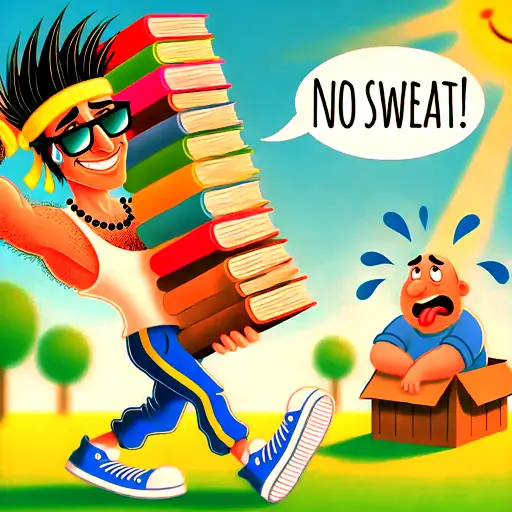"Pronunciation Made Perfect"
"Pronunciation Made Perfect"

[Some links on this site are affiliate links, meaning I may earn a commission if you make a purchase. This comes at no additional cost to you. Thank you for your support!]
Have you ever heard someone say, "No sweat," and wondered what they really meant? You're not alone! This common English idiom is a favorite among native speakers, but it can be a bit puzzling for those learning the language. In this post, we'll dive deep into the "No Sweat" idiom—exploring its meaning, origins, and how you can use it naturally in your conversations. Whether you're chatting with friends or writing an email, understanding this phrase can make your English sound more fluent and relatable.
The phrase "no sweat" has been part of the English language for quite some time. It originated from the literal idea of not breaking a sweat, meaning something is easy to do. Over time, it evolved into a metaphorical expression used to reassure someone that a task or favor is simple and won't cause any trouble.
The "No Sweat" idiom is versatile and finds its place in various conversational contexts. Understanding these contexts can help you use the phrase more naturally and appropriately. Let's delve deeper into how "No Sweat" is commonly used in different scenarios.
One of the most frequent uses of "No Sweat" is when someone asks for a favor or help. It's a casual and friendly way to show willingness without making it seem burdensome.
Example:
Friend: Can you lend me your notes from last week's lecture?
You: No sweat! I'll email them to you right after class.
Sometimes, you might want to preemptively offer help. Using "No Sweat" in such cases conveys that you're more than happy to assist.
Example:
You: Need any help with your project?
Colleague: That would be great, thanks!
You: No sweat, let's tackle it together.
When someone thanks you for something you've done, replying with "No Sweat" downplays the effort you put in, making the interaction more humble and friendly.
Example:
Coworker: Thanks for covering my shift yesterday.
You: No sweat! Anytime you need help.
Using "No Sweat" can also express confidence in your ability to complete a task effortlessly. It's a way to reassure others that something is manageable.
Example:
Manager: Can you prepare the presentation by tomorrow morning?
You: No sweat, I'll have it ready before the meeting.
In everyday chats, "No Sweat" adds a relaxed and approachable tone. It helps in building rapport and keeping the conversation light.
Example:
Friend: I'm nervous about the upcoming exam.
You: Don't worry, no sweat! You've studied hard and will do great.
Sometimes, you might use "No Sweat" to decline an offer without sounding dismissive, maintaining politeness and friendliness.
Example:
Neighbor: Want to join us for dinner tonight?
You: Thanks for the invite, but no sweat this time. Maybe next week!
When someone is hesitant or doubtful about their abilities, using "No Sweat" can serve as encouragement, boosting their confidence.
Example:
Friend: I'm not sure I can handle this assignment.
You: No sweat! Let's go through it together.
If you're looking to vary your language, here are some synonyms and related phrases:
Using different expressions can make your speech more dynamic and engaging.

Understanding the right moments to use "No Sweat" is key to making your English interactions smoother. Here are some detailed scenarios where this idiom fits perfectly:
Whether you're collaborating on a project or assisting a colleague, "No Sweat" can convey your readiness to contribute without any hesitation.
Example:
Boss: Can you finalize the report by end of day?
You: No sweat, I'll ensure it's completed and sent to you tonight.
When hanging out with friends, using "No Sweat" can make your responses feel more relaxed and genuine.
Example:
Friend: Can you pick me up from the airport?
You: No sweat, I'll be there at 6 PM.
In family interactions, "No Sweat" can help in maintaining a supportive and cooperative atmosphere.
Example:
Parent: Could you set the table for dinner?
You: No sweat, I'll have it done in a minute.
Students and teachers alike can use "No Sweat" to foster a friendly and encouraging learning environment.
Example:
Teacher: Can you explain this concept to the class?
Student: No sweat, I'd be happy to help everyone understand.
During parties or social events, "No Sweat" can be used to offer assistance or respond to invitations casually.
Example:
Host: Can you help me with the decorations?
You: No sweat, let's make this place look awesome!
English is a global language with various dialects, each having its unique expressions. While "No Sweat" is widely understood, different regions might prefer alternative phrases that convey the same meaning. Here’s a look at some variations:
In the UK, "No Sweat" is often replaced with phrases like "No bother" or "Not a problem."
Example:
British Friend: Can you pass me that book?
You: No bother! Here you go.
Australians frequently use "No worries" as an equivalent to "No Sweat." It's a staple in their everyday conversations.
Example:
Aussie Colleague: Could you cover my meeting tomorrow?
You: No worries, I’ve got it covered.
Similar to Australian English, Canadians also prefer "No worries" or "No problem."
Example:
Canadian Peer: Thanks for helping with the move.
You: No problem, happy to help out.
In Indian English, "No Sweat" is commonly used, much like in American and other forms of English. However, "Don't worry" is also prevalent.
Example:
Indian Friend: Can you take care of my plants while I'm away?
You: No sweat, I'll make sure they stay healthy.
South Africans might use "No worries" or "It's all good" interchangeably with "No Sweat."
Example:
South African Colleague: Can you join the meeting at 10?
You: It's all good, I'll be there on time.
Understanding these regional preferences can enhance your ability to communicate effectively with people from different English-speaking backgrounds.
While "No Sweat" is predominantly used in informal settings, it's essential to recognize when it's appropriate to use it and when to opt for more formal language.
In casual conversations with friends, family, or close colleagues, "No Sweat" fits right in and adds a friendly tone.
Example:
Friend: Can you help me move this weekend?
You: No sweat! Let's get everything sorted on Saturday.
In environments that require a balance between professionalism and friendliness, such as certain workplaces, "No Sweat" can be appropriate if used judiciously.
Example:
Coworker: Could you review this document for me?
You: No sweat, I'll go through it this afternoon.
In highly formal situations, such as official meetings, academic presentations, or professional correspondence, it's better to use more formal alternatives like "Certainly," "Of course," or "I'd be happy to."
Example:
Supervisor: Please prepare the financial report by Friday.
You: Certainly, I will have it ready by then.
To add variety and nuance to your conversations, you can combine "No Sweat" with other phrases. This not only enriches your language but also helps in expressing different shades of meaning.
Examples:
Friend: Can you babysit my kids tonight?
You: No sweat, I'd be happy to help out!Coworker: Could you join me for lunch?
You: No sweat, I'd love to!
While "No Sweat" is a handy phrase, overusing it can make your speech sound repetitive. To maintain a natural flow, mix it with other similar expressions like "No problem," "Sure thing," or "Absolutely."
Examples:
Friend: Can you help me with my homework?
You: Sure thing! Let's tackle it together.Coworker: Can you send me the latest report?
You: Absolutely, I'll email it to you shortly.
By varying your responses, you keep your conversations engaging and prevent any monotony.
Be mindful of cultural contexts when using "No Sweat." While it's widely accepted in many English-speaking regions, certain cultures or individuals might prefer more formal or different expressions. Always consider your audience to ensure your language is appropriate and respectful.
Example:
International Business Meeting:
Client: Can you provide the updated figures by tomorrow?
You: Certainly, I'll ensure they're sent by end of day.
In this context, opting for "Certainly" instead of "No Sweat" maintains professionalism and respect.
Pair up with a friend or classmate and act out the following scenarios using "No Sweat":
Scenario 1:
Person A: I need someone to cover my shift tomorrow.
Person B: No sweat, I can do that.
Scenario 2:
Person A: Can you help me study for the exam?
Person B: No sweat, let's start now.
Scenario 3:
Person A: Could you water my plants while I'm on vacation?
Person B: No sweat, I'll make sure they stay healthy.
Scenario 4:
Person A: Can you drive me to the airport on Saturday?
Person B: No sweat, I'll be there at 8 AM.
Scenario 5:
Person A: Would you mind proofreading my report?
Person B: No sweat, send it over and I'll review it.
Practicing these scenarios will help you feel more confident using the idiom in real-life conversations.
Test your understanding of the "No Sweat" idiom with these multiple-choice questions. Choose the best option to complete each sentence.
A: Can you help me move this weekend?
B: ________, let's get everything sorted on Saturday.
A: Could you send me the meeting minutes?
B: ________, I'll email them to you by noon.
A: I'm struggling with this assignment. Can you assist me?
B: ________, let's go through it together.
A: Would you mind covering my shift tonight?
B: ________, I can take care of it.
A: Can you pick up some groceries on your way home?
B: ________, I'll stop by the store now.
The "No Sweat" idiom is a handy phrase that adds a touch of ease and friendliness to your English conversations. Whether you're helping a friend or responding to a request, knowing how to use "no sweat" can make your interactions smoother and more natural. By expanding your understanding of how to use the "No Sweat" idiom in various contexts and recognizing regional variations, you can seamlessly incorporate this phrase into your everyday language. Remember to balance its use with other similar expressions to keep your speech dynamic and engaging. Keep practicing with the exercises above, and soon you'll find yourself using this idiom effortlessly. If you enjoyed this guide, subscribe to our newsletter for more tips on mastering English idioms and enhancing your language skills. Don't forget to share this post with friends who are also learning English!
Ready to take your English to the next level?
Thank you for trusting Mr. Practical English as your partner in language learning. Together, we'll make your journey enjoyable and successful!